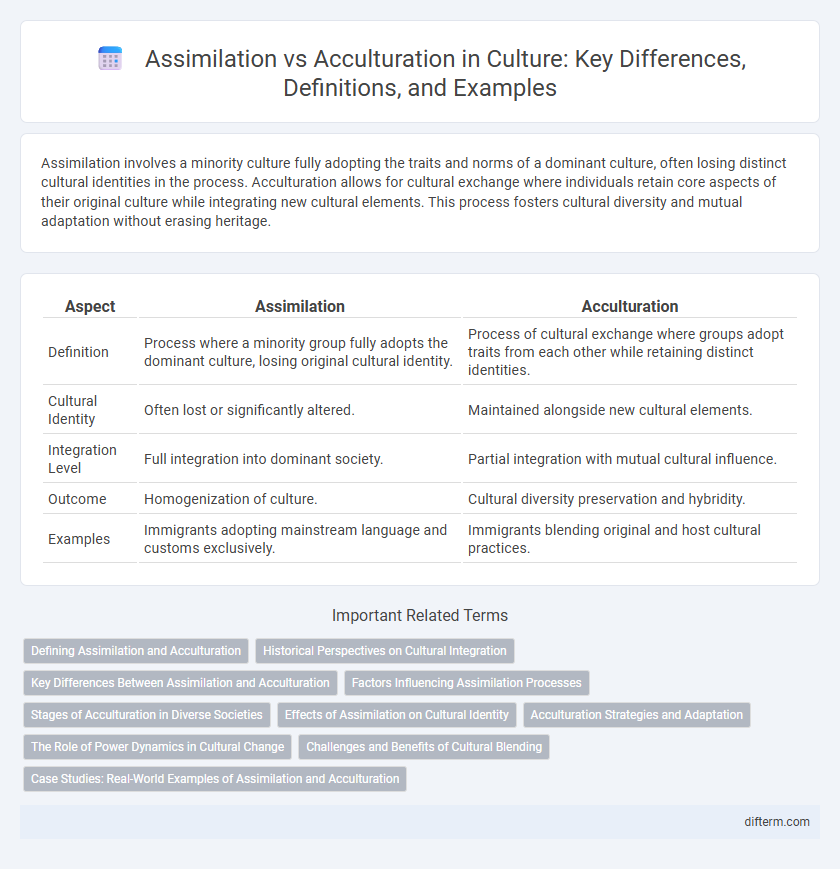Assimilation involves a minority culture fully adopting the traits and norms of a dominant culture, often losing distinct cultural identities in the process. Acculturation allows for cultural exchange where individuals retain core aspects of their original culture while integrating new cultural elements. This process fosters cultural diversity and mutual adaptation without erasing heritage.
Table of Comparison
| Aspect | Assimilation | Acculturation |
|---|---|---|
| Definition | Process where a minority group fully adopts the dominant culture, losing original cultural identity. | Process of cultural exchange where groups adopt traits from each other while retaining distinct identities. |
| Cultural Identity | Often lost or significantly altered. | Maintained alongside new cultural elements. |
| Integration Level | Full integration into dominant society. | Partial integration with mutual cultural influence. |
| Outcome | Homogenization of culture. | Cultural diversity preservation and hybridity. |
| Examples | Immigrants adopting mainstream language and customs exclusively. | Immigrants blending original and host cultural practices. |
Defining Assimilation and Acculturation
Assimilation involves individuals or groups fully adopting the cultural traits of another dominant society, often resulting in the loss of original cultural identity. Acculturation refers to the process where individuals or groups adopt certain cultural elements from another culture while maintaining aspects of their original culture. Both concepts highlight different approaches to cultural integration and identity transformation within multicultural environments.
Historical Perspectives on Cultural Integration
Historical perspectives on cultural integration reveal distinct processes of assimilation and acculturation that shaped societies. Assimilation involves the absorption of minority groups into dominant cultures, often erasing original cultural identities, as seen during 19th-century European colonial expansions. In contrast, acculturation allows for mutual cultural exchange and adaptation without complete loss of cultural distinctiveness, exemplified by the multicultural interactions in ancient Silk Road societies.
Key Differences Between Assimilation and Acculturation
Assimilation involves the complete integration of an individual or group into a dominant culture, often leading to the loss of original cultural identity, whereas acculturation allows for cultural exchange while retaining distinct cultural traits. Key differences include the degree of cultural change and identity preservation, with assimilation emphasizing conformity and acculturation promoting adaptation and coexistence. Research shows acculturation supports multiculturalism, while assimilation aligns with cultural homogenization.
Factors Influencing Assimilation Processes
Factors influencing assimilation processes include the length of residence in the host country, the strength of cultural ties to the origin community, and the openness of the receiving society. Socioeconomic status, language proficiency, and policies promoting integration also play critical roles in determining the rate and extent of assimilation. Interpersonal interactions between immigrant and native populations further shape the assimilation trajectory.
Stages of Acculturation in Diverse Societies
The stages of acculturation in diverse societies typically include initial contact, where individuals encounter a new culture; cultural adaptation, involving changes in behaviors and attitudes; and integration, where individuals blend aspects of both original and new cultures while maintaining their identity. Assimilation differs by emphasizing the gradual loss of the original culture in favor of the dominant culture, whereas acculturation allows for multicultural coexistence and selective cultural exchange. Understanding these stages informs policies promoting social cohesion and multiculturalism in increasingly globalized societies.
Effects of Assimilation on Cultural Identity
Assimilation often leads to the erosion of original cultural identities as individuals adopt the dominant culture's values, language, and customs, resulting in diminished cultural diversity. This process can cause a loss of traditional practices, languages, and social norms, weakening community bonds and heritage preservation. Over time, the pressure to conform in assimilation environments may create internal conflicts and identity struggles among minority groups.
Acculturation Strategies and Adaptation
Acculturation strategies include integration, separation, assimilation, and marginalization, each representing different ways individuals adapt to a new cultural environment. Integration involves maintaining one's original culture while participating in the host culture, often leading to better psychological and social adaptation outcomes. Effective adaptation through acculturation enhances cross-cultural communication, social cohesion, and individual well-being in multicultural societies.
The Role of Power Dynamics in Cultural Change
Power dynamics significantly shape the processes of assimilation and acculturation, determining which cultural traits are maintained, altered, or suppressed. Dominant groups often impose their values and norms during assimilation, leading to the marginalization of minority cultures, whereas acculturation involves mutual exchange influenced by unequal social, political, and economic power relations. Understanding these power imbalances is essential for analyzing how cultural identities transform and resist in diverse societies.
Challenges and Benefits of Cultural Blending
Cultural blending through assimilation often presents challenges such as identity loss and social exclusion, while acculturation tends to facilitate mutual adaptation and cultural exchange. Benefits of cultural blending include enhanced social cohesion, increased innovation, and broader worldviews that enrich communities. Navigating these processes requires balancing respect for heritage with openness to new influences to foster inclusive multicultural environments.
Case Studies: Real-World Examples of Assimilation and Acculturation
Case studies reveal that assimilation often results in minority groups adopting the dominant culture's language and customs, as seen in the Native American boarding schools in the United States. Acculturation, by contrast, involves a reciprocal exchange where both cultures adapt, such as the blending of Mexican and American traditions in the Southwestern U.S. These real-world examples highlight the differing impacts on identity retention and cultural integration.
assimilation vs acculturation Infographic

 difterm.com
difterm.com